An Interpretative Matrix for an Adaptive Design Approach. Italian School Infrastructure: Safety and Social Restoration
Abstract
1. Introduction
2. Architecture and Urban Design as a Tool for Transformation
Reuse as an Architectural Tool
3. Materials and Methods
Italian Schools
4. Definition of the Formal Matrix
4.1. Matrix 1: 1850–1920
4.2. Matrix 2: 1921–1955
4.3. Matrix 3: 1956–1975
4.4. Matrix 4: 1976–2000
4.5. The New School
4.6. Methodological Synthesis of the Matrix
5. Survey Methodology
5.1. Survey
5.2. List of Functions and Spatial Characteristics
5.3. Categorization
5.3.1. Systemic Category
5.3.2. Connective Category
5.3.3. Introverted Category
6. Adaptive Design Strategies
6.1. Systemic Strategy
- -
- Canteen;
- -
- Library/Auditorium;
- -
- Laboratories/Classrooms;
- -
- Gym;
- -
- Administration/Associations.
6.2. Connective Strategy
6.3. Introverted Strategy
7. First Conclusions and Future Research Developments
Author Contributions
Funding
Conflicts of Interest
References
- INDIRE. The Avanguardie Educative Manifesto. Available online: http://pheegaro.indire.it/uploads/attachments/1946.pdf (accessed on 5 August 2020).
- Alexander, C. The Timeless Way of Building; Oxford University Press: New York, NY, USA, 1979. [Google Scholar]
- Pollo, R. Why architecture quality? In RE—Waterfront. A Sustainable Architectural Approach; Dahl, P.J., Pollo, R., Thiebat, F., Micono, C., Zanzottera, F., Eds.; Franco Angeli: Milano, Italy, 2019. [Google Scholar]
- U.S.R.C. Ufficio Speciale Per la Ricostruzione dei Comuni del Cratere. Available online: http://www.usrc.it/home/chi-siamo (accessed on 28 June 2020).
- Elmqvist, T.; Bai, X.; Frantzeskaki, N.; Griffith, C.; Maddox, D.; McPhearson, T.; Parnel, S.; Romero-Lankao, P.; Simon, D.; Watkins, M. (Eds.) Urban Planet—Knowledge towards Sustainable Cities; Cambridge University Press: Cambridge, UK, 2018; pp. 462–482. [Google Scholar] [CrossRef]
- Elmqvist, T.; Andersson, E.; Frantzeskaki, N.; McPhearson, T.; Olsson, P.; Gaffney, O.; Takeuchi, K.; Folke, C. Sustainability and Resilience for Transformation in the Urban Century. Nat. Sustain. 2019, 2, 267–273. [Google Scholar] [CrossRef]
- Pearson, L.J.; Newton, P.W.; Roberts, P. (Eds.) Resilient Sustainable Cities—A Future; Routledge: New York, NY, USA, 2014. [Google Scholar]
- Tankard, C. How secure is your building? Netw. Secur. 2015, 2015, 5–8. [Google Scholar] [CrossRef]
- Castaldo, P.; Ferrentino, T. Seismic Reliability-Based Design Approach for Base-Isolated Systems in Different Sites. Sustainability 2020, 12, 2400. [Google Scholar] [CrossRef]
- Palazzo, B.; Castaldo, P.; Vecchia, P.D. Seismic reliability analysis of base-isolated structures with friction pendulum system. In Proceedings of the 2014 IEEE Workshop on Environmental, Energy and Structural Monitoring Systems, Napoli, Italy, 17–18 September 2014; pp. 1–6. [Google Scholar] [CrossRef]
- Long, J. Constructing the narrative of the sustainability fix: Sustainability, social justice and representation in Austin, TX. Urban Stud. 2016, 53, 149–172. [Google Scholar] [CrossRef]
- What is Horizon 2020? Available online: https://ec.europa.eu/programmes/horizon2020/en/what-horizon-2020 (accessed on 7 June 2020).
- Kilicay-Ergin, N.; Colin, J.; Neill, C.J.; Sangwan, R.S. Integrating object-process methodology with attribute driven design. In Proceedings of the Annual IEEE Systems Conference (SysCon), Orlando, FL, USA, 18–21 April 2016; pp. 1–8. [Google Scholar]
- Boholm, M. The semantic field of risk. Saf. Sci. 2017, 92, 205–216. [Google Scholar] [CrossRef]
- Boholm, M.; Möller, N.; Hansson, S.O. The Concepts of Risk, Safety, and Security: Applications in Everyday Language. Risk Anal. 2016, 36, 320–338. [Google Scholar] [CrossRef]
- Bubnovskaia, O.V.; Leonidova, V.V.; Lysova, A.V. Security or Safety: Quantitative and Comparative Analysis of Usage in Research Works Published in 2004–2019. Behav. Sci. 2019, 9, 146. [Google Scholar] [CrossRef]
- Enciclopedia Treccani. Available online: http://www.treccani.it/vocabolario/ricerca/progettare/ (accessed on 3 June 2020).
- Cuff, D. Architecture: The Story of Practice; The MIT Press: Cambridge, MA, USA, 1992. [Google Scholar]
- Yaneva, A. Made by the Office for Metropolitan Architecture: An Ethnography of Design; 010 Publishers: Rotterdam, The Netherlands, 2009. [Google Scholar]
- Yaneva, A. The Making of a Building: A Pragmatist Approach to Architecture; Peter Lang AG: Oxford, UK, 2009. [Google Scholar]
- Cayer, A. From Archive to Office: The Role of History in Theories of Architecture Practice. Ardeth 2018, 2, 35–51. [Google Scholar] [CrossRef]
- Pollio, M.V. De Architectura. The Architecture of Marcus Vitruvius Pollio; Gwilt, J., Translator; Lockwood &CO: London, UK, 1874; Available online: https://warburg.sas.ac.uk/pdf/kfh125b2128022.pdf (accessed on 7 May 2020).
- Alberti, L.B. De Re Aedificatoria. Available online: http://www.antichefornaci.it/blog/biblioteca/leon-battista-alberti-de-re-aedificatoria-tradotto-da-cosimo-bartoli-1784/ (accessed on 7 May 2020).
- Plowright, P.D. Revealing Architectural Design: Methods, Frameworks and Tools; Routledge: London, UK, 2014; pp. 14–17. [Google Scholar]
- Bocchi, R.; Marini, S. Re-Cycle Italy. In search of new life-cycles for the territories of waste and abandonment. Techne J. Technol. Archit. Environ. 2015, 10, 16–18. [Google Scholar]
- Van Eyck, A. Beyond Visibility, about Place and Occasion, the in between Realm, Labyrinthian Clarity. In For Us; 1962; Available online: http://www.artefacts.co.za/main/Buildings/articles.php?artid=1863 (accessed on 10 October 2020).
- Hertzberger, H. Space and the Architect; 010 Publishers: Rotterdam, The Netherlands, 2000. [Google Scholar]
- Smithson, A. (Ed.) Team 10 Primer; Studio Vista & Reinhold: New York, NY, USA, 1968. [Google Scholar]
- Sennett, R. The Open City. Housing and Urban Neighbourhoods; Urban Age; Newspaper Essay Berlin: Berlin, Germany, 2006; Available online: https://esteticartografias07.files.wordpress.com/2008/07/berlin_richard_sennett_2006-the_open_city1.pdf (accessed on 12 July 2020).
- Deleuze, G.; Guattari, F. A Thousand Plateaus; University of Minnesota Press: Minneapolis, MN, USA, 1987. [Google Scholar]
- Ingaramo, R. Rust Remix; LetteraVentidue: Syracuse, Italy, 2017. [Google Scholar]
- Baima, L.; Robiglio, M. Intensity of Uses and Spatial Devices. In Abandoned Buildings in Contemporary Cities: Smart Conditions for Actions; Lami, I.M., Ed.; Springer: Cham, Germany, 2020. [Google Scholar] [CrossRef]
- Venturi, R.; Brown, D.S.; Izenour, S. Learning from Las Vegas, 1st ed.; The MIT Press: Cambridge, MA, USA, 1977. [Google Scholar]
- Wilkinson, S. The Context for Building Resilience through Sustainable Change of Use Adaptation: Building Urban Resilience through Change of Use; Wiley: Melbourne, Australia, 2018; pp. 1–20. [Google Scholar]
- Robiglio, M. RE-USA. 20 American Stories of Adaptive Reuse; Jovis: Barcelona, Spain, 2017. [Google Scholar]
- Bullen, P.A. Adaptive reuse and sustainability of commercial buildings. Facilities 2007, 25, 20–31. [Google Scholar] [CrossRef]
- Douglas, J. Building Adaptation; Routledge: New York, NY, USA, 2006. [Google Scholar]
- Langston, C.A. The sustainability implications of building adaptive reuse. In Proceedings of the International Research Symposium on Advancement of Construction Management and Real Estate (CRIOCM 2008), Beijing, China, 31 October–3 November 2008; pp. 1–12. [Google Scholar]
- Ball, R. Re-use potential and vacant industrial premises: Revisiting the regeneration issue. Stoke Trent. J. Prop. Res. 2002, 19, 93–110. [Google Scholar] [CrossRef]
- Science Communication Unit. Science for Environment Policy. No net land take by 2050? Future Brief 14. 2016. Available online: http://ec.europa.eu/science-environment-policy (accessed on 20 June 2020).
- Mohamed, R.; Boyle, R.; Yilun, A.Y.; Tangari, J. Adaptive reuse: A review and analysis of its relationship to the 3 Es of sustainability. Facilities 2017, 35, 138–154. [Google Scholar] [CrossRef]
- Kurul, E. A Qualitative Approach to Exploring Adaptive Re-use processes. Facilities 2007, 25, 554–570. [Google Scholar] [CrossRef]
- Grillo, F. Una Scuola Ristrutturata a Torino, Circondata da Pergolati Sospesi. Domusweb, 25 September 2019. Available online: https://www.domusweb.it/it/architettura/gallery/2019/09/25/una-scuola-ristrutturata-a-torino-circondata-da-pergolati-sospesi.html (accessed on 27 July 2020).
- Fabian, L.; Giannotti, E.; Viganò, P. (Eds.) Recycling City, Lyfecycles, Embodied Energy, Inclusion; Giavedoni: Pordenone, Italy, 2012. [Google Scholar]
- Bocchi, R.; Ippolito, F. Riciclare la città. IBC XXI 2013, 2, 1–5. [Google Scholar]
- Fabian, L.; Munarin, S. (Eds.) Re-CycleItaly. Atlante; LetteraVentidue: Syracuse, Italy, 2017. [Google Scholar]
- ESFA. Condition Data Collection, Guide for Schools. 2017. Available online: https://assets.publishing.service.gov.uk/government/uploads/system/uploads/attachment_data/file/652226/Condition_Data_Collection__CDC__Guide_for_Schools.pdf (accessed on 25 July 2020).
- Perraudin, F. Revealed: One in six schools in England require urgent repairs. Guardian 2019, 8. Available online: https://www.theguardian.com/education/2019/dec/08/revealed-one-in-five-school-buildings-in-england-require-urgent-repairs (accessed on 5 June 2020).
- Iovino, R.; Fascia, F.; Lignola, G. (Eds.) Edilizia Scolastica: Riqualificazione Funzionale Ed Energetica, Messa In Sicurezza, Adeguamento Antisismico; Dario Flaccovio Editore: Palermo, Italy, 2014. [Google Scholar]
- Legambiente. Ecosistema Scuola—XIX Rapporto di Legambiente Sulla Qualità Dell’edilizia Scolastica, Delle Strutture e dei Servizi, Legambiente Onlus. 2018. Available online: https://www.legambiente.it/wp-content/uploads/ecosistema_scuola_2018.pdf (accessed on 16 May 2020).
- Cittadinanzattiva. Available online: https://www.cittadinanzattiva.it/comunicati/scuola/12609-sicurezza-a-scuola-presentato-il-xvii-rapporto-di-cittadinanzattiva.html (accessed on 28 June 2020).
- MIUR, Anagrafe Dell’edilizia Scolastica. Available online: https://www.istruzione.it/edilizia_scolastica/anagrafe.shtml (accessed on 15 July 2020).
- Fondazione Giovanni Agnelli. Rapporto Sull’edilizia Scolastica; Editori Laterza: Bari, Italy, 2019. [Google Scholar]
- Weyland, B.; Altmann, U.S.; Galletti, A. Scuole in Movimento. Progettare Insieme tra Pedagogia Architettura e Design; Franco Angeli: Milano, Italy, 2019. [Google Scholar]
- Weyland, B.; Attia, S. Progettare Scuole tra Pedagogia e Architettura; Guerini e Associati: Milano, Italy, 2015. [Google Scholar]
- Woolner, P. School Design Together; Routledge: New York, NY, USA, 2015. [Google Scholar]
- Hille, R.T. Modern Schools: A Century of Design for Education; Wiley: Hoboken, NJ, USA, 2011. [Google Scholar]
- Nair, P.; Fielding, R.; Lackney, J. The Language of School Design: Design Patterns for 21 Century Schools; Designshare: Minneapolis, MN, USA, 2013. [Google Scholar]
- Dudek, M. Architecture of Schools: The New Learning Environments; Architectural Press: Oxford, UK, 2000. [Google Scholar]
- Thayer-Bacon, B. Maria Montessori, John Dewey, and William H. Kilpatrick. Educ. Cult. 2012, 28, 3–20. [Google Scholar] [CrossRef][Green Version]
- Haskins, C. The Montessori Method. J. Unschooling Altern. Learn. 2010, 4, 40–57. [Google Scholar]
- Piaton, G. La Pensée Pédagogique De Célestin Freinet; Privat: Toulouse, France, 1974. [Google Scholar]
- Lippman, P. Evidence-Based Design of Elementary and Secondary Schools: A Responsive Approach to Creating Learning Environments; Wiley: Hoboken, NJ, USA, 2010. [Google Scholar]
- Serreli, S.; Calidoni, P. Citta’ e Formazione; Hoepli Editorei: Milano, Italy, 2018. [Google Scholar]
- Parsons, T. The school class as a social system: Some of its functions in American Society. Harv. Educ. Rev. 1959, 29, 297–318. [Google Scholar]
- Dovey, K.; Fisher, K. Designing for adaptation: The school as socio-spatial assemblage. J. Archit. 2014, 19, 43–63. [Google Scholar] [CrossRef]
- Michelucci, M. Prospettive Storiche E Problemi Attuali Sull’educazione, Studi In Onore Di Ernesto Cadignola; La Nuova Italia: Florence, Italy, 1960. [Google Scholar]
- Torino fa Scuola. Available online: https://www.torinofascuola.it/ (accessed on 15 June 2020).
- Troisi, R.; Alfano, G. Towns as Safety Organizational Fields: An Institutional Framework in Times of Emergency. Sustainability 2019, 11, 7025. [Google Scholar] [CrossRef]
- Lucarelli, M.T.; Pennestrì, D. Gli edifici scolastici e l’indoor air quality: Procedure diagnostiche e criteri di intervento/School buildings and indoor air quality: Diagnostic procedures and criteria for intervention. Techne J. Technol. Archit. Environ. 2015, 9, 299–306. [Google Scholar]
- Checchi, P.; Marcetti, C.; Meringolo, P. La Scuola E La Città; Polistampa: Reggio Emilia, Italy, 2010. [Google Scholar]
- Coppino, M. Legge 3961 del 15 luglio 1877—Regolamento per la Legge Sull’istruzione Scolastica. Available online: https://www.icpiazzaforlanini.edu.it/wp-content/uploads/2015/07/Legge_Coppino1.pdf (accessed on 2 September 2020).
- Grimoldi, A.; Landi, A.G. Structural Problems in Italian School Buildings of the Late Nineteenth Century; Research Paper; Politecnico di Milano: Milan, Italy, 2014. [Google Scholar]
- Terragni, G. Asilo D’infanzia per il Rione Sant’ Elia Como, 21 Maggio Xiv; Tomarin: Como, Italy, 1936. [Google Scholar]
- Kirkpatrick, J. Montessori, Dewey, and Capitalism: Educational Theory for a Free Market in Education; TLJ Books: Claremont, CA, USA, 2008. [Google Scholar]
- Catarci, M.; Susi, F. Scuola, Società, Politica, Democrazia. Dalla Riforma Gentile ai Decreti Delegati. Roma: Armando. J. Educ. Cult. Psychol. Stud. 2012, 3, 231–234. [Google Scholar]
- Cataldi, S. Public Sociology and Participatory Approaches. Towards a Democratization of Social Research? Qual. Sociol. Rev. 2014, 10, 152–172. [Google Scholar]
- Palanti, M. Scuola al Lido di Roma. Progetto dell’architetto Ignazio Guidi. Architettura 1934, XII, 623–625. Available online: http://www.casadellarchitettura.eu/inglese/index.php?do=fascicoli&idFascicolo=360&idRiviste=5 (accessed on 4 May 2020).
- Rogers, E.N. Dramma di una scuola. Casabella Contin. 1960, 245, 142–150. [Google Scholar]
- D.P.R. 1 dicembre 1956, n. 1688. Approvazione di Nuove Norme per la Compilazione dei Progetti di Edifici ad Uso Delle Scuole Elementari e Materne. Available online: http://www.edizionieuropee.it/LAW/HTML/15/zn38_08_002.html (accessed on 4 May 2020).
- Ministero della Pubblica Istruzione. Servizio Centrale per l’Edilizia e l’Arredamento della Scuola. In Scuole Minime: Studi, Schemi e Progetti; Stabilimenti tip. E. Ariani e L’arte della stampa: Florence, Italy, 1953. [Google Scholar]
- Legge 24 Settembre 1971, n. 820, (in GU 14 October 1971, n. 261). Norme Sull’ordinamento Della Scuola Elementare e Sulla Immissione in Ruolo Degli Insegnanti Della Scuola Elementare e Della Scuola Materna Statale. Available online: https://www.edscuola.it/archivio/norme/leggi/l820_71.html (accessed on 4 May 2020).
- Domusweb. Italy in the 1970s: School Architecture and its Conceptual Territory. In Proceedings of the 4th Istanbul Design Biennial Architecture, Istanbul, Turkey, 22 September–4 November 2018; Available online: https://www.domusweb.it/en/events/istanbul-design-biennial/2018/09/17/italy-in-the-1970s-school-architecture-and-its-conceptual-territory.html (accessed on 4 May 2020).
- D.M. 21 Marzo 1970, “Norme Tecniche Relative All’edilizia Scolastica, ivi Compresi gli Indici Minimi di Funzionalita’ Didattica, Edilizia ed Urbanistica, da Osservarsi Nella Esecuzione di Edilizia Scolastica”. Available online: https://www.gazzettaufficiale.it/eli/id/1970/06/01/1314Q001/sg (accessed on 2 March 2020).
- D.M. 18 Dicembre 1975, Norme Tecniche Relative all’edilizia Scolastica, ivi Compresi Gli Indici Minimi di Funzionalita’ Didattica, Edilizia ed Urbanistica, da Osservarsi Nella Esecuzione di Edilizia Scolastica. 2 February 1976, n. 29. Available online: http://anagrafeediliziascolastica.regione.marche.it/mappla/documentiedilizia/DM_18121975.pdf (accessed on 2 March 2020).
- L.R. 05 Settembre 1972, n. 8 (1), Norme per L’esercizio Delle Funzioni di Competenza della Regione Lazio in Materia di Urbanistica e di Assetto del Territorio (2). Available online: http://www.consiglio.regione.lazio.it/consiglio-regionale/?vw=leggiregionalidettaglio&id=7083&sv=vigente (accessed on 4 May 2020).
- De Micheli, L.; Campanini, N.; Ciaffi, D.; Facilla, F.W.; Giuffrè, R. Piano Di Zona 167 di Rome; Comune di Rome: Rome, Italy, 1980. [Google Scholar]
- Inaugurate a Torino le nuove Fermi e Pascoli: Qui Nasce la Scuola del Futuro, 12 September 2019. La Stampa online. Available online: https://www.lastampa.it/torino/2019/09/12/news/torino-fa-scuola-debuttano-i-nuovi-istituti-hi-tec-1.37449450 (accessed on 20 July 2020).
- Zucconi, M.; Ferlito, R.; Sorrentino, L. Simplified survey form of unreinforced masonry buildings calibrated on data from the 2009 L’Aquila earthquake. Bull. Earthq. Eng. 2018, 16, 2877–2911. [Google Scholar] [CrossRef]
- DL 17 ottobre 2016, n. 189, DL 9 Febbraio 2017, n. 8, Nuovi Interventi Urgenti in Favore Delle Popolazioni Colpite Dagli Eventi Sismici del 2016 e del 2017. Available online: https://www.gazzettaufficiale.it/eli/id/2017/02/09/17G00021/sg (accessed on 4 May 2020).
- Allegato 1—Elenco dei Comuni Colpiti dal Sisma del 24 Agosto 2016—ai Sensi del Comma 13 bis dell’art.48 e Dell’allegato 1 del Decreto Legge 186/2016, Convertito Dalla Legge 229 del 15 Dicembre 2016, Allegato 2—Elenco dei Comuni Colpiti dal Sisma del 26 e del 30 Ottobre 2016—ai Sensi del Comma 13 bis dell’art.48 e dell’Allegato 2 del Decreto Legge 186/2016, Convertito Dalla Legge 229 del 15 Dicembre 2016, Allegato 2 bis—Elenco dei Comuni Colpiti dal Sisma del 18 Gennaio 2017—ai Sensi dell’art. 18—Undicies e Dell’allegato 2 bis del Decreto Legge 8/2017, Convertito Dalla Legge 45 del 7 aprile 2017. Available online: https://www.sara.it/fileadmin/user_upload/Documenti/Libero_domani/elenco_comuni_colpiti_da_sisma_27_luglio_2017.pdf (accessed on 4 May 2020).
- Scuola in Chiaro. Available online: https://www.miur.gov.it/-/scuola-in-chiaro (accessed on 26 May 2020).
- Technological Research Area, Group of Research on Educational Spaces. INDIRE, Manifesto Learning space 1 + 4. 2018. Available online: http://www.indire.it/wp-content/uploads/2016/03/ARC-1602-Manifesto-Inglese_LOW.pdf (accessed on 4 May 2020).
- Charleson, A. Seismic Design for Architects; Architectural Press, Elsevier: Oxford, UK, 2018; p. 96. [Google Scholar]
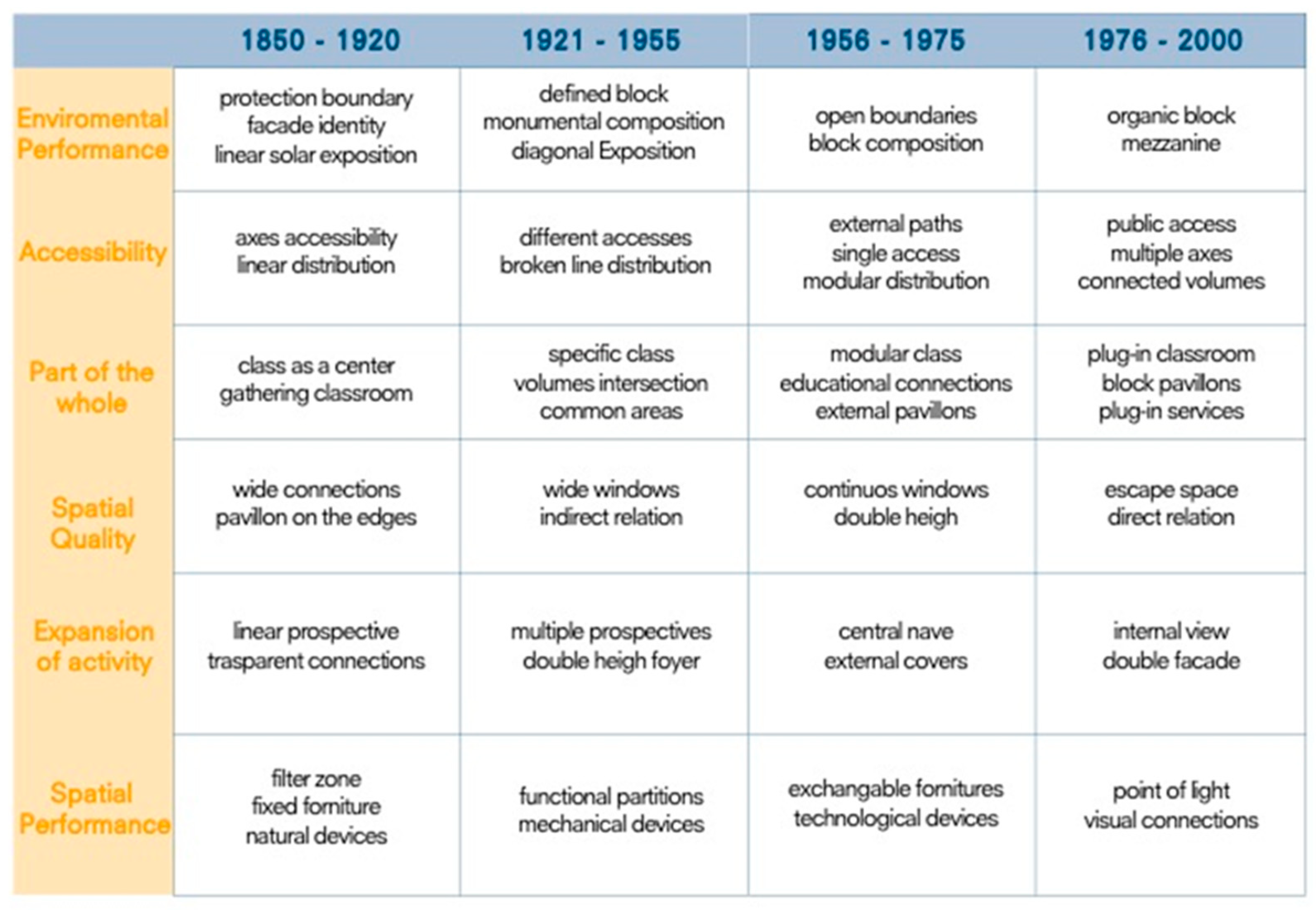
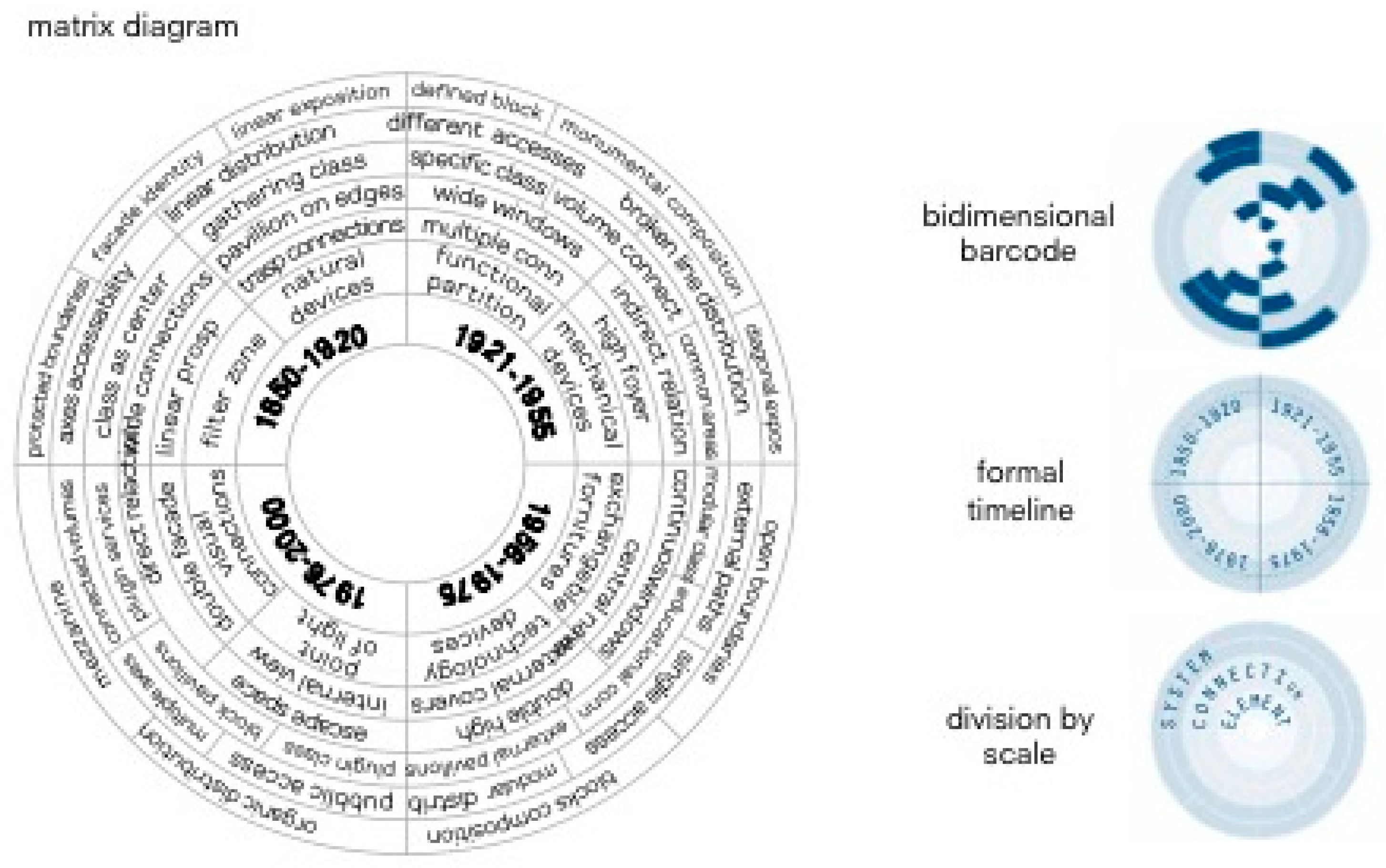
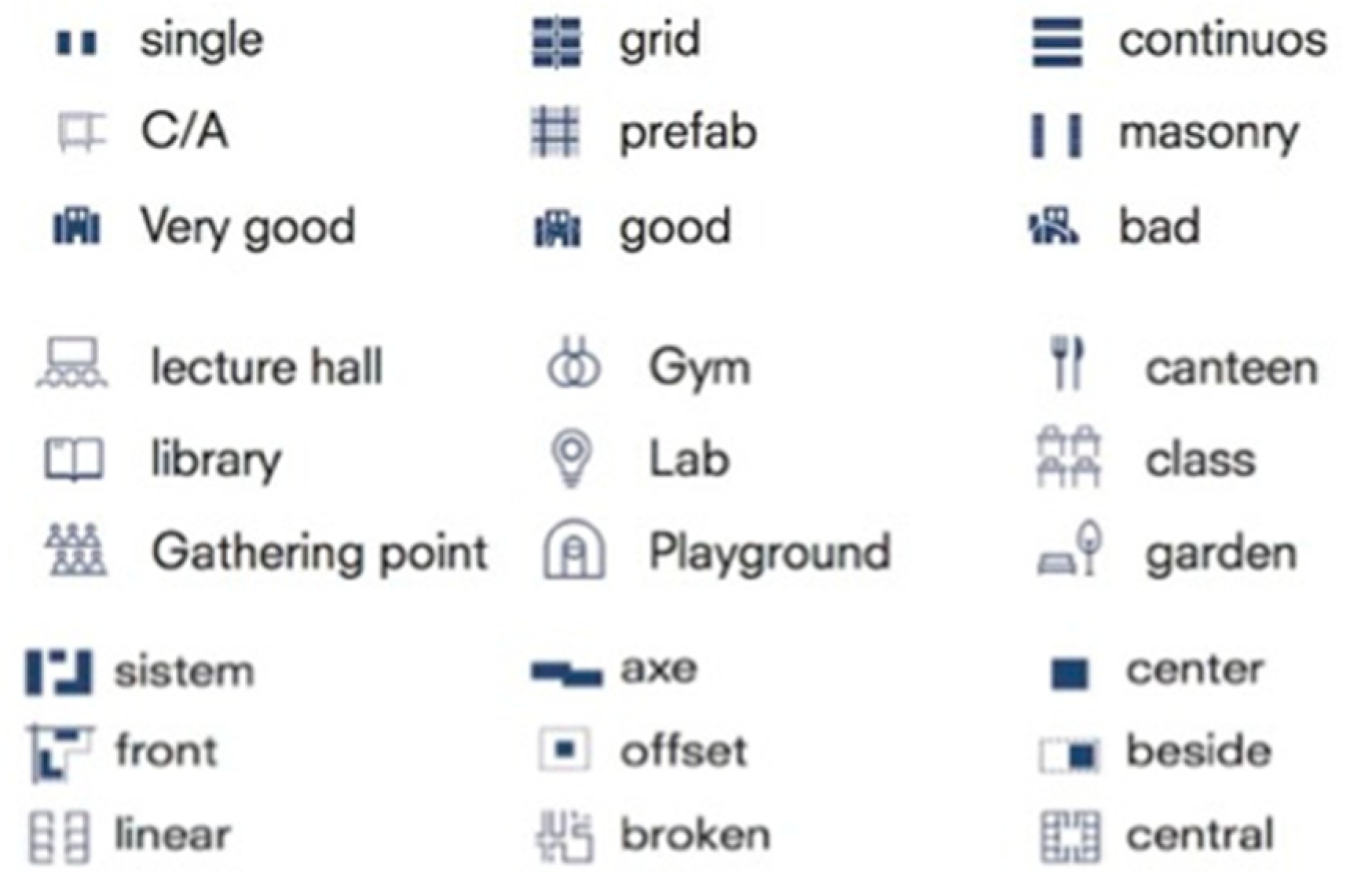



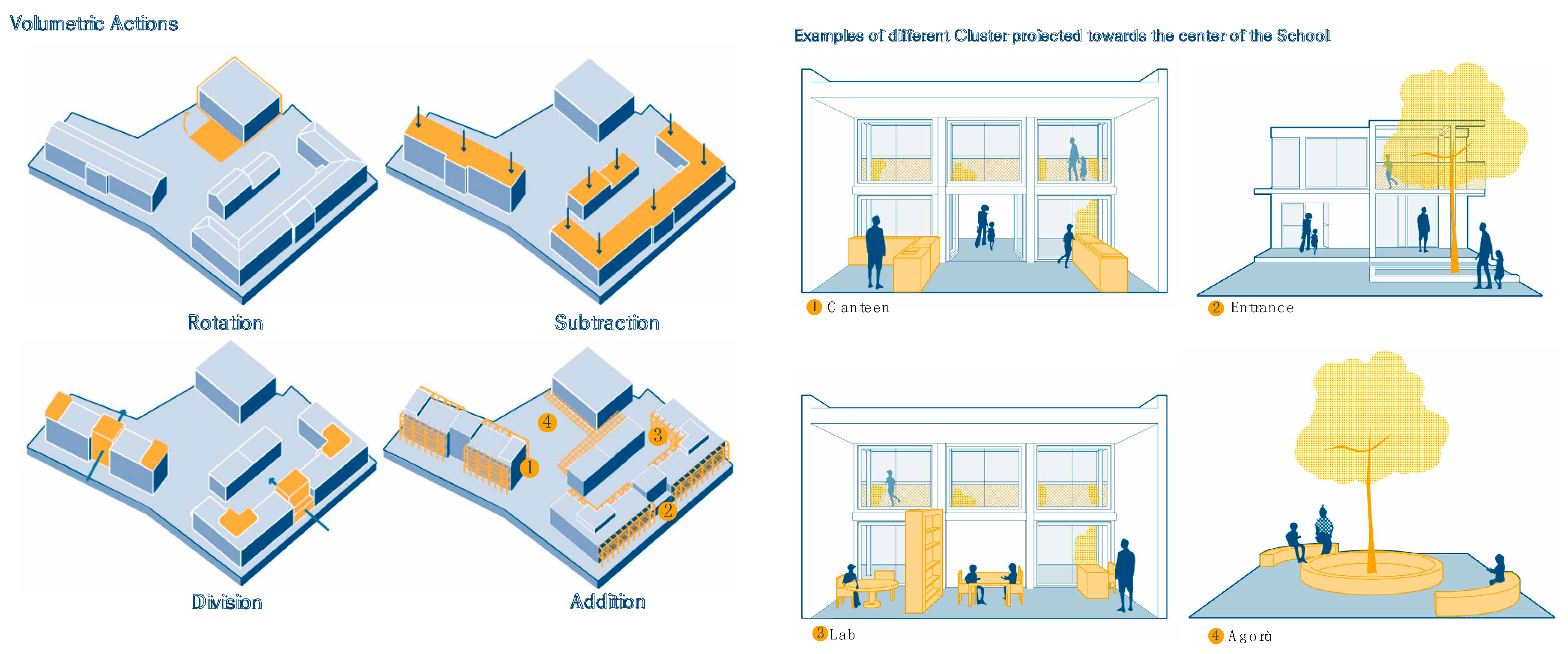
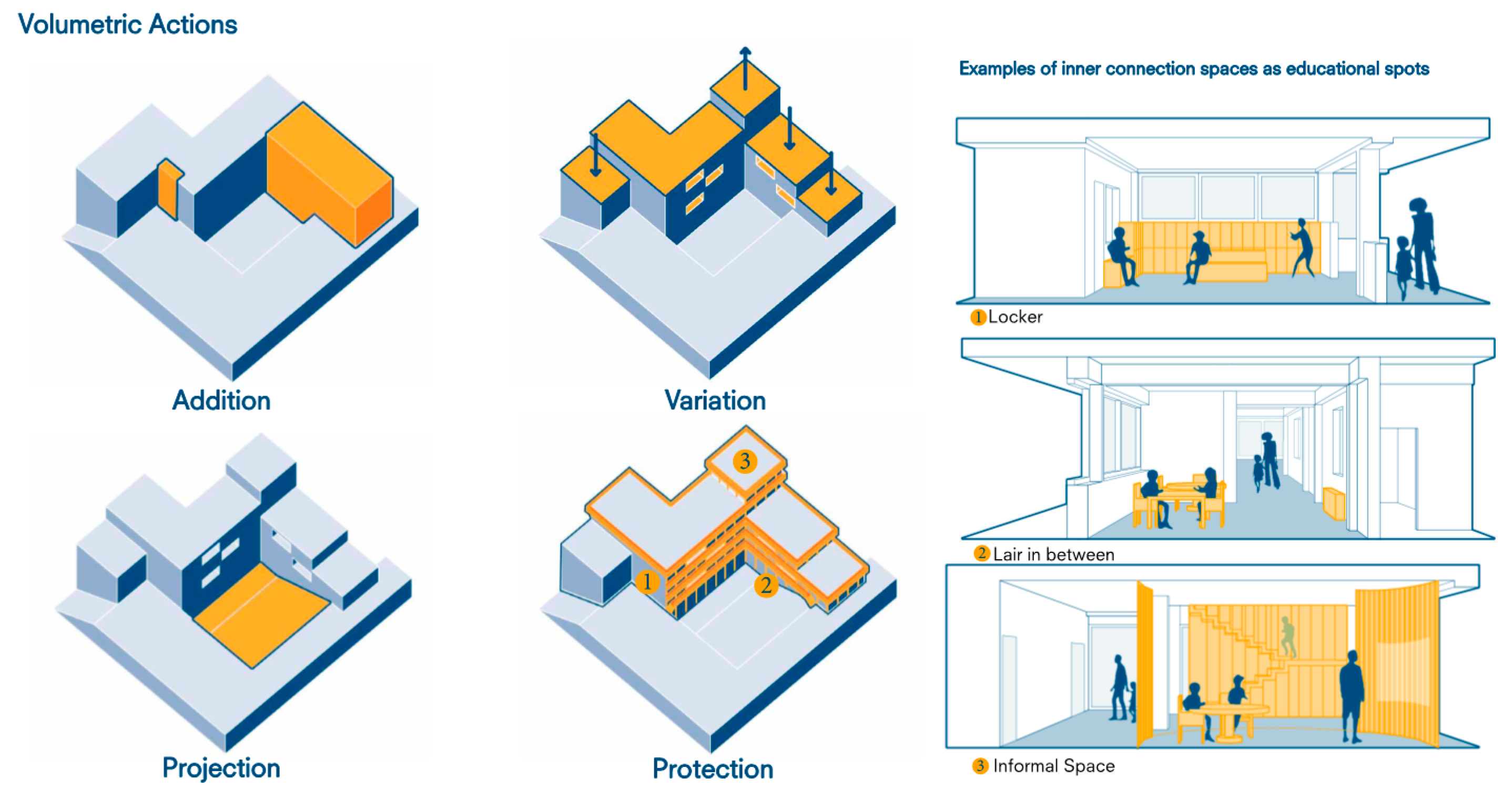
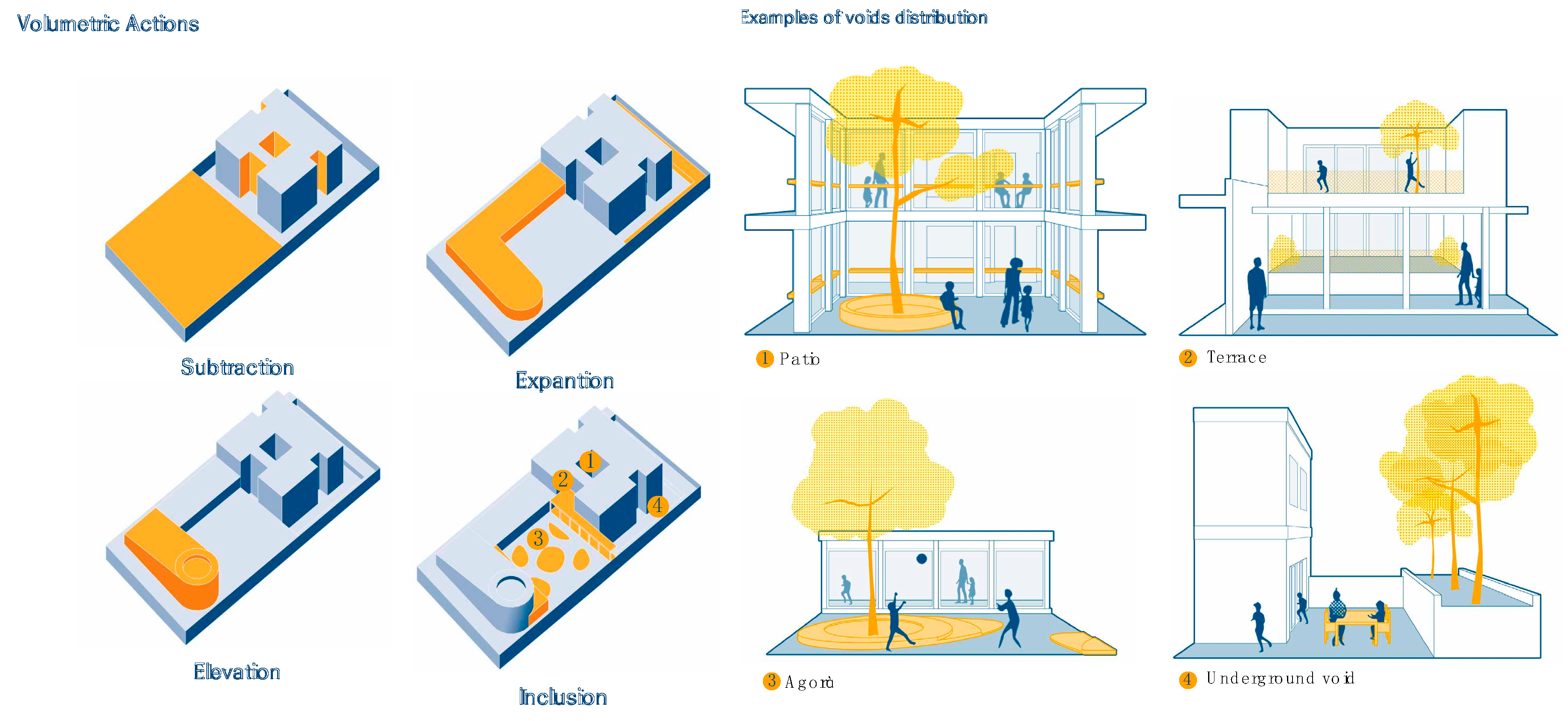
© 2020 by the authors. Licensee MDPI, Basel, Switzerland. This article is an open access article distributed under the terms and conditions of the Creative Commons Attribution (CC BY) license (http://creativecommons.org/licenses/by/4.0/).
Share and Cite
Ingaramo, R.; Pascale, L. An Interpretative Matrix for an Adaptive Design Approach. Italian School Infrastructure: Safety and Social Restoration. Sustainability 2020, 12, 8354. https://doi.org/10.3390/su12208354
Ingaramo R, Pascale L. An Interpretative Matrix for an Adaptive Design Approach. Italian School Infrastructure: Safety and Social Restoration. Sustainability. 2020; 12(20):8354. https://doi.org/10.3390/su12208354
Chicago/Turabian StyleIngaramo, Roberta, and Luca Pascale. 2020. "An Interpretative Matrix for an Adaptive Design Approach. Italian School Infrastructure: Safety and Social Restoration" Sustainability 12, no. 20: 8354. https://doi.org/10.3390/su12208354
APA StyleIngaramo, R., & Pascale, L. (2020). An Interpretative Matrix for an Adaptive Design Approach. Italian School Infrastructure: Safety and Social Restoration. Sustainability, 12(20), 8354. https://doi.org/10.3390/su12208354




